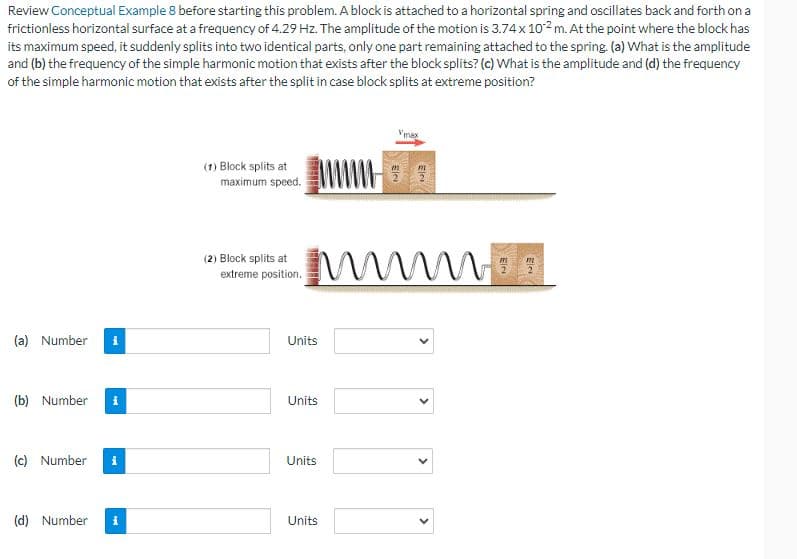Review Conceptual Example 8 before starting this problem. A block is attached to a horizontal spring and oscillates back and forth on a frictionless horizontal surface at a frequency of 4.29 Hz. The amplitude of the motion is 3.74 x 102 m. At the point where the block has its maximum speed, it suddenly splits into two identical parts, only one part remaining attached to the spring. (a) What is the amplitude and (b) the frequency of the simple harmonic motion that exists after the block splits? (c) What is the amplitude and (d) the frequency of the simple harmonic motion that exists after the split in case block splits at extreme position? (a) Number i (1) Block splits at maximum speed. (2) Block splits at extreme position. www Vmax mmm Wa Units Elet
Simple harmonic motion
Simple harmonic motion is a type of periodic motion in which an object undergoes oscillatory motion. The restoring force exerted by the object exhibiting SHM is proportional to the displacement from the equilibrium position. The force is directed towards the mean position. We see many examples of SHM around us, common ones are the motion of a pendulum, spring and vibration of strings in musical instruments, and so on.
Simple Pendulum
A simple pendulum comprises a heavy mass (called bob) attached to one end of the weightless and flexible string.
Oscillation
In Physics, oscillation means a repetitive motion that happens in a variation with respect to time. There is usually a central value, where the object would be at rest. Additionally, there are two or more positions between which the repetitive motion takes place. In mathematics, oscillations can also be described as vibrations. The most common examples of oscillation that is seen in daily lives include the alternating current (AC) or the motion of a moving pendulum.
I am still needing help with understanding how to work this practice problem out. Thank you very much for your help.

Trending now
This is a popular solution!
Step by step
Solved in 6 steps with 6 images

The practice problem is saying that part d- 4.29 is not correct. Thank you so much for your help.








